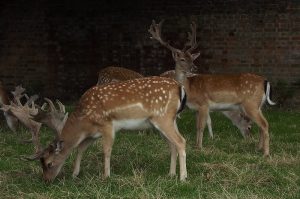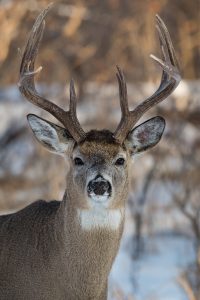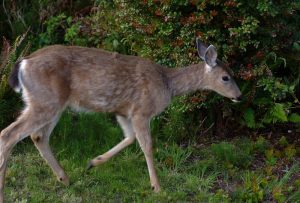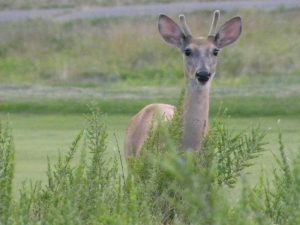Do you have a deer problem around your trees? The level of deer damage your trees may experience depends on the types of trees, their location and other factors. Sometimes, the symptoms of deer around your trees will only happen at a certain time of the year, such as during the rutting season. Other times, it will be year-round.
Some of the most common signs of a deer problem include:
- Buck Rubs
- Chewed Foliage
- Deer Droppings
- Hoof Prints
- Fawns
So how you can eliminate the risk of deer in your backyard? There are a few different steps that you can take.
Eliminate Plants & Trees That Attract Deer

Credit: Heather Smithers
- Try not to plant things deer love
- Avoid trees that drop acorns
- Harvest produce as soon as you can
You may have specific plants and trees in your yard that attract deer in general. If you happen to have a vegetable garden or fruit trees, harvest the produce as soon as it is ready for picking – do not delay. This will prevent the deer from detecting something tasty is nearby and bringing their entire family over for lunch.
Another great option, according to Bonnie’s Plants, is to plant vegetables that deer may not find appetizing in order to mask the scent of the foods that are more appetizing. These can include rhubarb, asparagus, and garlic. Position these plants around the border to protect the rest of your garden. Alternatively, plant them around the sides that are closest to the street, which is how deer will likely enter into your yard.
Another option is to keep your vegetable garden closer to your home. Deer are less likely to venture near your home when they can hear and smell you.
Keep Up With Your Landscaping

Credit: Martin Svedén
- Keep grasses short
- Trim densely planted areas
- Deer love cover
Deer love tall grass and shrubbery to bed down in for the night. One of the worst things you can do is keep your vegetation long enough where they will want to create a bed, according to Farm and Fleet. If you see some of your vegetation trampled down, you already have a problem. Eliminate any cover by trimming back grass, trees, shrubs, and plants.
Use best practices when mowing and trimming to avoid spreading disease. If you already have a deer problem in your yard and your vegetation is dense, you may want to look around first so that you don’t stumble upon any babies that are being protected. If you do see a fawn, back away slowly. You can trim when they have left.
Consider Getting A Sprinkler

Credit: Sunny
- Use a timer to help eliminate deer
- Motion activation will work better
- This tool startles them but doesn’t harm them
Another great way to keep deer at bay is to invest in a sprinkler system. Deer hate being surprised, and a harmless blast of water will startle them so that they run away. Sprinklers also tend to have a warning sound, which could scare them away as well. These will work throughout the night and during the day. A timed sprinkler can also work, but it won’t really be as effective.
While you shouldn’t buy a sprinkler just for this reason, it is a consideration. You should have a sprinkler system if you have a garden and trees, so it may just be another reason to get one. A sprinkler will also help to keep away rodents, stray dogs, and robbers, according to Theme Country.
Remember that you shouldn’t use a sprinkler during a drought or in the winter months when it can cause freezing on the ground.
Create A Border Using Hedges

Credit: Avi
- Certain shrubs will keep deer away
- Deer are less likely to jump over thick hedges they can’t see through
- Plan for hedge maintenance
If you’re interested in landscaping, another option is to create a border around your yard using hedges. These tend to be more effective than fences because they are wide and deer can’t jump over them. Most of the fences we see are shorter and deer can easily get over them if there is something that they want on the other side.
According to Havahart, “Boxwoods and other thick hedges can be used to keep deer out. These plants line the yard’s perimeter and act as a border or a wall, deterring deer from crossing through. Because deer can’t see through the hedges into the yard, they may decide to skip your yard and head elsewhere because it’s too risky for them to proceed. Keep hedges well maintained so they stay full and continue to block the view into your yard.”
Consider Deer Repellents

Credit: slgckgc
- Make sure to do your research
- Try natural solutions first
- They don’t smell great
If you are really stuck and need a final solution to keep deer out of your yard, one last option is to use a deer repellent spray. These sprays use chemicals and some natural ingredients to keep the deer out of your yard. They don’t always have the best ingredients and they can make the yard unpleasant for other animals, including humans. The biggest problem? They smell quite unpleasant.
Predator Guard explains why they work so well: “A deer’s olfactory gland, or sense of smell, is far superior to ours. By way of comparison, the nose of a deer has up to 297 million olfactory receptors, dogs have 220 million, and humans peak at just 5 million.” So you can just imagine how bad they smell to the deer if they smell that bad to you.
If you are looking for a tree care professional in Southern Ontario, give Van Till Tree Care a call today at (705) 653-3777. We will help you to better understand your trees and advise you on particular issues with your high risk trees. We can help you with many other issues that you might find among your trees – from the very top of the tree to the roots, no matter how old they are.
Header photo credit: magnetismus

